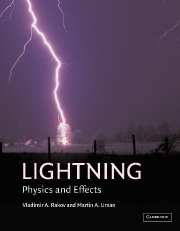Book contents
- Frontmatter
- Contents
- Preface
- 1 Introduction
- 2 Incidence of lightning
- 3 Electrical structure of lightning-producing clouds
- 4 Downward negative lightning discharges to ground
- 5 Positive and bipolar lightning discharges to ground
- 6 Upward lightning initiated by ground-based objects
- 7 Artificial initiation (triggering) of lightning by ground-based activity
- 8 Winter lightning in Japan
- 9 Cloud discharges
- 10 Lightning and airborne vehicles
- 11 Thunder
- 12 Modeling of lightning processes
- 13 The distant lightning electromagnetic environment: atmospherics, Schumann resonances, and whistlers
- 14 Lightning effects in the middle and upper atmosphere
- 15 Lightning effects on the chemistry of the atmosphere
- 16 Extraterrestrial lightning
- 17 Lightning locating systems
- 18 Deleterious effects of lightning and protective techniques
- 19 Lightning hazards to humans and animals
- 20 Ball lightning, bead lightning, and other unusual discharges
- Appendix: Books on lightning and related subjects
- Index
17 - Lightning locating systems
Published online by Cambridge University Press: 05 June 2013
- Frontmatter
- Contents
- Preface
- 1 Introduction
- 2 Incidence of lightning
- 3 Electrical structure of lightning-producing clouds
- 4 Downward negative lightning discharges to ground
- 5 Positive and bipolar lightning discharges to ground
- 6 Upward lightning initiated by ground-based objects
- 7 Artificial initiation (triggering) of lightning by ground-based activity
- 8 Winter lightning in Japan
- 9 Cloud discharges
- 10 Lightning and airborne vehicles
- 11 Thunder
- 12 Modeling of lightning processes
- 13 The distant lightning electromagnetic environment: atmospherics, Schumann resonances, and whistlers
- 14 Lightning effects in the middle and upper atmosphere
- 15 Lightning effects on the chemistry of the atmosphere
- 16 Extraterrestrial lightning
- 17 Lightning locating systems
- 18 Deleterious effects of lightning and protective techniques
- 19 Lightning hazards to humans and animals
- 20 Ball lightning, bead lightning, and other unusual discharges
- Appendix: Books on lightning and related subjects
- Index
Summary
Lightning detection and mapping systems can be used to minimize the harmful effects of lightning by providing early warnings of such hazards. These systems can also be used to determine how much lightning actually occurs within a given region and the statistics of discharge parameters that are important in research and in the design of lightning protection systems.
E.P. Krider (1994)Introduction
There are many individual physical processes in cloud and ground flashes. Each of these processes has associated with it characteristic electric and magnetic fields. Lightning is known to emit significant electromagnetic energy in the frequency range from below 1 Hz to near 300 MHz, with a peak in the frequency spectrum near 5 to 10 kHz for lightning at distances beyond 50 km or so. As noted in Section 1.3, at frequencies higher than that of the spectrum peak, the spectral amplitude varies roughly in inverse proportion to the frequency up to 10 MHz or so and in inverse proportion to the square root of frequency from about 10 MHz to 10 GHz. Further, electromagnetic radiation from lightning is detectable at even higher frequencies, for example, in the microwave, 300 MHz to 300 GHz and, obviously, in visible light, roughly 1014 to 1015 Hz. In addition to electromagnetic radiation, lightning produces the acoustic radiation discussed in Chapter 11. In general, any observable signal from a lightning source can be used to detect and locate the lightning process that produced it. Acoustic locating techniques, including acoustic-signal time of arrival and acoustic ray tracing, are described in Section 11.5 and hence are not discussed further here.
Information
- Type
- Chapter
- Information
- LightningPhysics and Effects, pp. 555 - 587Publisher: Cambridge University PressPrint publication year: 2003
Accessibility standard: Unknown
Why this information is here
This section outlines the accessibility features of this content - including support for screen readers, full keyboard navigation and high-contrast display options. This may not be relevant for you.Accessibility Information
- 10
- Cited by
